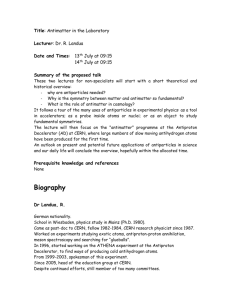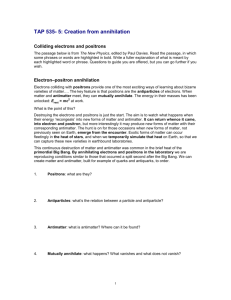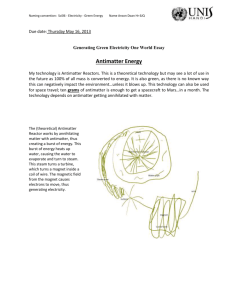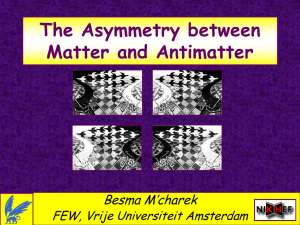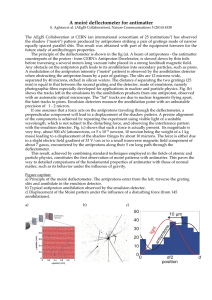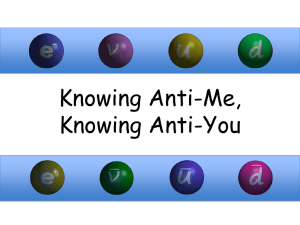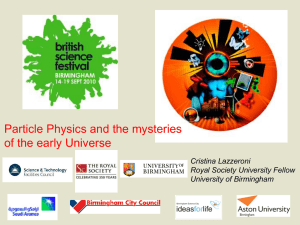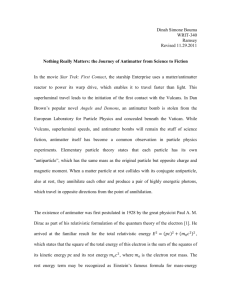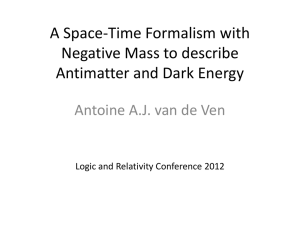The Antiproton Decelerator inside CERN`s antimatter facility
advertisement
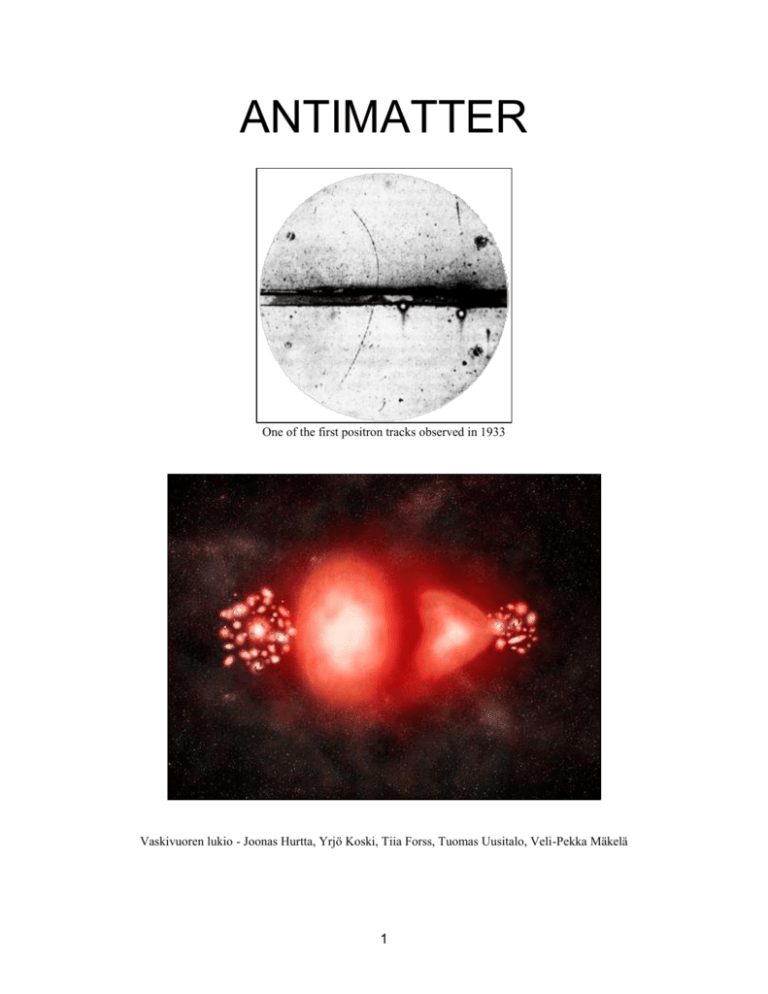
ANTIMATTER One of the first positron tracks observed in 1933 Vaskivuoren lukio - Joonas Hurtta, Yrjö Koski, Tiia Forss, Tuomas Uusitalo, Veli-Pekka Mäkelä 1 Table of contents Introduction 3 History until 1995 3 History since 1995 4 Production 5 Problems in theoretical physics of antimatter 5 Antimatter - CERN experiments 7 Antimatter - Problems of the now 9 The current applications of antimatter 10 Possible future applications of antimatter 11 Resources 12 2 Introduction Antimatter is material that is composed of antiparticles, which have the same mass as ordinary particles, but have other differing properties, such as electrical charge. If an ordinary particle comes into contact with its antiparticle, like electron and positron, they annihilate, turn into energy. Photo from here, antimatter on top History until 1995 The term antimatter was first coined in 1898 by a british physicist Arthur Schuster, but it was just speculation about antiatoms, that also possessed negative gravity. In 1928 a british physicist Paul Dirac developed an equation that implied the existence of antimatter, the positron. The first positrons were discovered by Carl D. Anderson in 1932, confirming the existence of antimatter. In 1933, Paul Dirac predicted the existence of antiproton in his Nobel Prize lecture. 22 years later it was confirmed experimentally by physicists Emilio Segrè and Owen Chamberlain from University of California. A year later, the antineutron was discovered. In 1964, James Cronin and Val Fitch discovered that matter and antimatter have more differences than just electrical charge. This raised a question: is antimatter exactly equal and opposite to matter, as Dirac had predicted? Could an antinucleus be formed? In 1965, researchers both in Europe and in the USA observed the antideuteron, consisting of an antiproton and an antineutron. 3 History since 1995 First antimatter atoms were produced in 9.15.1995 at CERN’s Low Energy Antiproton Ring facility. They were produced in collisions between antiprotons and xenon atoms. Atoms remained in existence for only about 40 billionth of a second. They travelled at nearly the speed of light and then annihilated with ordinary matter after going over a path of 10 meters. In 1997 CERN approved an Antiproton Decelerator after closing down other antiproton machines - the Antiproton Accumulator, the Antiproton Collector and the Low Energy Antiproton Ring - in 1996. In 2002 CERN created thousands of “cold” antimatter atoms in two experiments called ATHENA and ATRAP. Cold means that the atoms move so slowly that they are easy to study before they annihilate with ordinary matter. CERN’s ALPHA experiment succeeded in trapping antimatter atoms for over 16 minutes in 2011. 16 minutes is long enough to study the properties of antimatter atoms in detail. Trapping antiatoms will allow using laser or microwave spectroscopy so that the properties of antihydrogen atom can be compared to the hydrogen atom. The antimatter facility inside CERN 4 Production Antihydrogen can be produced by combining antiprotons and positrons. It is really hard to make them combine into antihydrogen because the circumstances must be just right. Temperature must be around -258°C and the Antihydrogen atoms will annihilate almost instantly unless they are trapped. Antiprotons can be produced easier. Protons are accelerated into almost the speed of light and then collided with a copper plate or iridium atoms. Collision will produce antiprotons along with ordinary particles. Antiprotons are then separated from protons by using magnetic fields. Positrons can be obtained via Beta decay. Problems in theoretical physics of antimatter As antimatter are created in high-energy collisions, they are immediately annihilated when getting in contact with an matter particle. Both matter and antimatter annihilates into energy in the collision. In standard model and particle physics it’s natural assumption that all charges are naturalized, like proton has a pair, electron, to reverse the positive charge back to zero. So in the big bang it’s assumed that same amount of matter and antimatter were created. This would mean 5 that today there would be the same amount both of them, but the world mostly consists of matter. But then there would be another problem. If there was equal amount of matter and antimatter they would’ve annihilated so that in the end there wouldn’t be any matter or antimatter. And without matter, the universe we know wouldn’t exist. Although antimatter is like a mirror image to matter and it’s thought that the laws to matter would apply to antimatter too, laws to antimatter must be a little different in comparison to matter to make the difference between them. Standard model nor particle physics are able to explain why the quantity of matter and antimatter are different so baryogenesis has been created to explain the imbalance between matter and antimatter. In the beginning there could’ve been a little disparity, which made the amounts of matter increase and antimatter decrease. In a split of a second, in the collisions of matter and antimatter after big bang, antimatter would disappear and all the excess matter created the planets with the energy which was created in the collisions. It has been estimated that for every ‘’3 million antiquarks there would be 3 million and 1 quarks.’’ Although there hasn’t been any clarified information from the physicist, what causes the disparity between them, but a theory called higgsogenesis could the the key. Higgsogenesis’s basic idea is that in the beginning for some reason there was a little asymmetry with anti-higgs and higgs which caused the particles to have that distority too. This theory would match with the standard model because it doesn’t exclude anti-higgs existence in the early universe. The physicists at CERN are researching why the disparity between antimatter and matter has occurred and hope to find hints about it with Large Hadron Collider (LHC). 6 Antimatter – CERN experiments Antiproton Decelerator (AD) is the main site for antimatter research at CERN. Its primary use is to slow down antiprotons and produce antihydrogen for experimenting. These experiments study different qualities of antimatter, such as spectrum, interaction with gravity and comparison with regular hydrogen. The AD produces antimatter from antiprotons and positrons. Because antiprotons will annihilate when in contact with regular matter, all of the experiments must be made in a high vacuum. Antiprotons are produced by accelerating protons to very high velocities in the Proton Synchrotron and then having them collide to rods of iridium. The protons will collide with the iridium nuclei at sufficiently high energy for matter to be created. Energy turns into matter and particles are born, antiprotons among them. The rate of antiprotons generated is about 4 antiprotons to 1 million protons. Antiprotons are then separated from the other, unwanted particles using magnetic fields. Then the antiprotons are guided to the AD for cooling. Cooling the antiprotons is done with cool dense electron plasma. Antiprotons collide with cold electrons and some of their energy is transferred into the electrons. This keeps happening until thermal equilibrium is attained. Once the antiprotons are sufficiently cooled they are sent to a trap made of magnetic and electrical fields to be paired with positrons. Some of the antiprotons will combine with positrons and produce antihydrogen which can thereafter be studied further. Positrons are generally collected from β+ decaying sodium-22 isotope. There are currently 4 experiments being carried out at the AD: - ATRAP (Antihydrogen trap) studies the differences between hydrogen and antihydrogen. Recently they discovered that the magnetic moment of antiproton is the exact opposite of a proton, as expected. - ASACUSA (Atomic Spectroscopy And Collisions Using Slow Antiprotons) experiment recently managed to create a beam of antihydrogen. A flow of 80 antihydrogen atoms was detected. A beam of this magnitude is a major step towards spectroscopic understanding of 7 antihydrogen. Another important find made by ASACUSA is the measuring of antiproton’s mass. In this experiment they replaced one of the electrons of a helium atom with an antiproton, creating antiprotonic helium. The electron-antiproton ratio could then be measured and antiprotons mass was found to be the same as protons to nine significant features. - ACE (Antiproton Cell Experiment) is about using antiprotons as medical treatment, cancer therapy. The general idea is to use antimatter’s annihilating effect. The antiproton is meant to be sent to tumor cells, and then have it annihilate, releasing energy and destroying cancer cells. ACE is the first experiment considering biological uses of antimatter. - ALPHA (Antihydrogen Laser PHysics Apparatus) experiment’s ultimate goal is to test CPT symmetry on antihydrogen. The way to do this would be to compare the spectra of both hydrogen and antihydrogen. So far laser spectroscopy hasn’t been able to be completed. Either the antihydrogen atoms are too energetic to be examined or are in their excited state, which would distort the spectrum. -AEGIS (Antimatter Experiment: Gravity, Interferometry, Spectroscopy) is a future experiment, focusing on the gravitational interaction of antimatter versus that of matter. The Antiproton Decelerator inside CERN’s antimatter facility 8 Antimatter – Problems of the Now Antimatter is arguably the hardest thing to store on earth. This is simply because of the volatile nature of antimatter. The high vacuum itself is hard to make, but then to control the uncharged particle from hitting the walls of the container. With charged particles this is not such a problem, them being controllable by electric and magnetic fields. The problem arises with neutral antihydrogen. They must be contained with magnetic traps only. For this, octpoles are used. Octupole magnet creates a magnetic field that surrounds the trap and keeps the particles in the center. Even with this technology, the only way for the scientists to know whether they’ve caught antimatter or not is to switch off the magnet and analyze the tracks left in the sensors after the antimatter annihilates. We all want to see antimatter-powered spacecrafts and whatnot, but that might be just too utopistic. At the current rate of antimatter production, it would take about billion years to generate 1 gram of antihydrogen. The process is also highly energy consuming: the amount of energy used to create 1 g of antihydrogen is a billion times more than the energy contained in its mass. 9 The current applications of antimatter Antimatter is currently used mainly for medical purposes. One type of medical scan, the PET (Positron Emission Tomography) relies in the use of positrons. In PET, a short-lived radioactive tracer isotope that undergoes β+decay is given or injected to the patient (usually to their blood circulation). When the radioisotope undergoes β+-decay, it will emit positrons that travel very short distances inside body tissue (<1mm) until they have lost enough kinetic energy and decelerated enough to be able to interact with an electron. That encounter annihilates both the positron and the electron by producing a pair of gamma ray photons that travel to approximately opposite directions. These gamma rays are then detected by the medical personnel using the scanning device (gamma photons are detected when they reach a scintillator in the scanning device, creating a burst of light that can be detected using photomultiplier tubes). This technique depends on simultaneous/coincident detection of photons at the opposite sides of the scanner ring. The radionuclides that are commonly used are isotopes with short half-lives such as carbon-11, nitrogen-18, oxygen-15 and fluorine-18. Other radionuclides than fluorine-18 must be produced on site because of the relatively short half-lives (2-20min). The used radiotracers have traditionally been produced using a cyclotron near the PET facility. These radionuclides are commonly incorporated into the tracer that is usually a glucose analogue, which is taken in high quantities by the brain, the liver and most cancers - allowing the detection of tumours. 10 The possible future applications of antimatter CERN is currently studying the effects of antiproton irradiation for cancer therapy. Current particle beam therapy uses protons to destroy tumour cells inside the patient. ACE experiment results have shown that antiprotons are at least four times more effective than protons at terminating live cells. There might be a big breakthrough in the upcoming years regarding the use of antimatter in cancer therapy. Many people have wondered about the possibility of using isolated and stored antimatter as fuel for interstellar travel. There are / have been researchers at least in the United States working with NASA on futuristic concepts for antimatter induced fission engines. Antimatter wouldn’t be the main source of energy for these spacecrafts, but would instead used to split heavy nuclei. Antimatter could also be used as the sole energy source of the spacecraft and this type of spacecraft would have a much higher thrust-to-weight ratio than traditional spacecraft. However, even for the NASA application we would need around 100,000 times more antimatter than is produced per year on Earth combined (People have also thought about capturing the naturally occurring antiprotons from the Van Allen radiation belt). In addition, many serious technical issues (storage, capture, transport) would have to overcome. The U.S Air Force has been interested in military uses of antimatter since the Cold War, when it began funding antimatter-related physics research. The primary technological advantage of antimatter weapons would be that antimatter-matter collisions convert a much greater friction of the weapon’s mass into energy. There is a simple reason why we won’t be seeing antimatter weapons in the near future; we can’t accumulate enough of it at high enough density. And the cost would be absurdly high (tens of millions of dollars per nanogram), in addition to the many other problems that antimatter has (storage, creation. According to CERN, “There is no possibility to make antimatter bombs for the same reason you cannot use it to store energy: we can't accumulate enough of it at high enough density. (...) If we could assemble all the antimatter we've ever made at CERN and annihilate it with matter, we would have enough energy to light a single electric light bulb for a few minutes.", but this would be a considerable feat because the accumulated antimatter would weigh less than one billionth of a gram.” 11 Resources Close, Frank. Antimatter. New York: Oxford University Press, 2009 http://web.mit.edu/panic11/talks/monday/PARALLEL-2G/5-1720/fujiwara/Fujiwara_PANIC2011v2_web.pdf http://socrates.berkeley.edu/~fajans/ALPHA_Spanish/EN_almacenamiento.htm http://www.sciencedaily.com/releases/2011/06/110605132421.htm http://angelsanddemons.web.cern.ch/antimatter/making-antimatter http://psdoc.web.cern.ch/PSdoc/acc/ad/index.html http://home.web.cern.ch/about/experiments/ace http://home.web.cern.ch/about/experiments/atrap http://aegis.web.cern.ch/aegis/ http://alpha.web.cern.ch/ http://www.iop.org/publications/iop/2013/file_59436.pdf http://asacusa.web.cern.ch/ASACUSA/asacusaweb/main/main.shtml http://www.bbc.co.uk/news/science-environment-13667475 http://en.wikipedia.org/wiki/Baryogenesis http://home.web.cern.ch/topics/antimatter/matter-antimatter-asymmetry-problem http://www.iop.org/resources/topic/archive/antimatter/ http://en.wikipedia.org/wiki/Positron_emission_tomography http://en.wikipedia.org/wiki/Antimatter http://library.thinkquest.org/26995/antiuses.html http://www.smartplanet.com/blog/intelligent-energy/the-practical-uses-of-antimatter/ http://press.web.cern.ch/press-releases/2006/10/antiprotons-four-times-more-effective-protons-cell-irradiation http://home.web.cern.ch/topics/antimatter http://athena-positrons.web.cern.ch/ATHENA-positrons/wwwathena/FAQ.html http://www.engr.psu.edu/antimatter/papers/nasa_anti.pdf http://en.wikipedia.org/wiki/Antimatter_weapon http://www.bibliotecapleyades.net/ciencia/ciencia_antimatterweapon.htm 12
